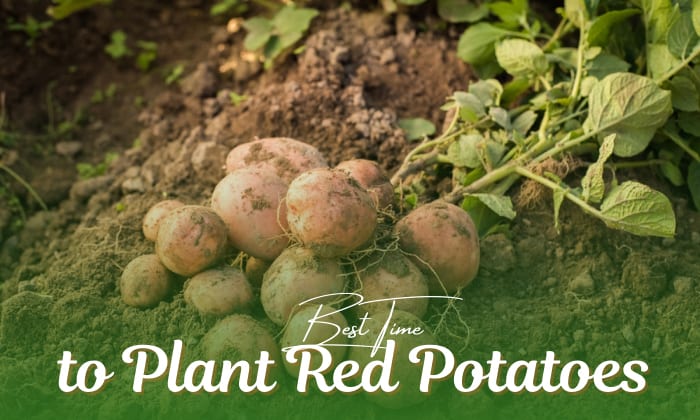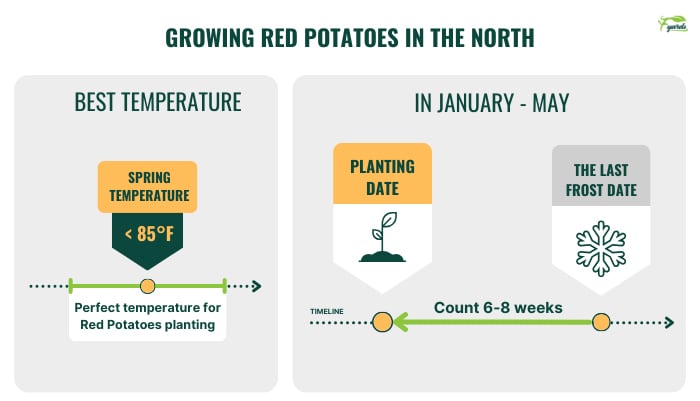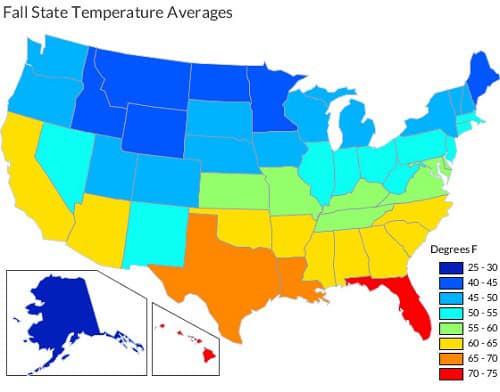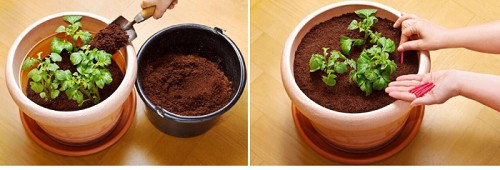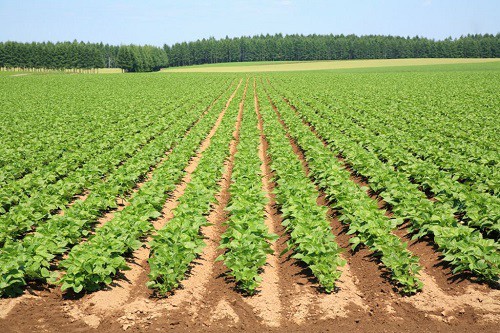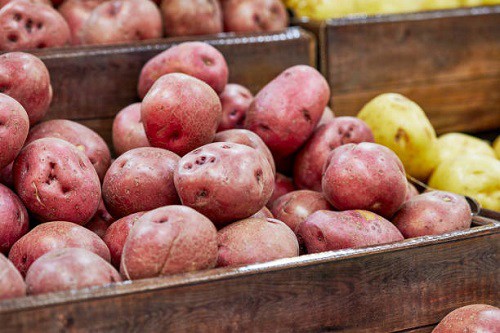When to plant red potatoes? One should plant red potatoes 6 to 8 weeks before the last frost in the north and in September to February in the south. The primary reason for such variation is that red potato is a mid-cold-season variety. Of course, there is much more to planting red potatoes, which we’ll explore in the sections below.
Table of Contents
Best Time to Plant Red Potatoes
Before looking at the exact time for planting red potatoes, it is essential to understand the conditions they need.
- The temperature should be below 85°F. If the temperature increases above that, it can result in leaf crinkle and cell damage. Consequently, yield will decrease.
- Before planting red potatoes, ensure your area gets at least 7 to 8 hours of sunlight. They might not grow well with less sunshine, and the tubers will be
Now, we will discuss the planting time for northern and southern regions.
1. Planting in the North
Visit almanac.com/gardening/frostdates and use your zip code to find your region’s frost estimates.
Example:
For zip code 10001, the last frost date is April 3; therefore, the time for planting red potatoes is six to eight weeks before that, or February 6 to 20.
Red potatoes can take up to 4 weeks (minimum 2) to sprout, so it’s essential to protect them against freezing weather by using mulch or covers. You may also delay planting until after the last frost if you’re worried about cold temperatures damaging your crops.
2. Planting in the south
Red potatoes can grow in the south from September to February. Since southern US states experience comparatively milder winters, red potatoes can also be planted in these regions as a fall crop. Refer to the table below for state-wise planting times.
| States | Zones | Suggested planting times |
| Alabama | Zone 7 | March to April |
| Zone 8 | March 14 | |
| Zone 9 | February 14th | |
| Arkansas | Zone 6 | April 7th |
| Zone 7 | March to April | |
| Zone 8 | March 14 | |
| Delaware | Zone 7 | March to April |
| Florida | Zone 8 | March 14 |
| Zone 9 | February 14th | |
| Zone 10 | February | |
| Zone 11 | Year-round | |
| Georgia | Zone 6 | April 7th |
| Zone 7 | March to April | |
| Zone 8 | March 14 | |
| Zone 9 | February 14th | |
| Kentucky | Zone 6 | April 7th |
| Zone 7 | March to April | |
| Louisiana | Zone 8 | March 14 |
| Zone 9 | February 14th | |
| Zone 10 | February | |
| Maryland | Zone 5 | April 15th |
| Zone 6 | April 7th | |
| Zone 7 | March to April | |
| Zone 8 | March 14 | |
| Mississippi | Zone 7 | March to April |
| Zone 8 | March 14 | |
| Zone 9 | February 14th | |
| North Carolina | Zone 5 | April 15th |
| Zone 6 | April 7th | |
| Zone 7 | March to April | |
| Zone 8 | March 14 | |
| Oklahoma | Zone 6 | April 7th |
| Zone 7 | March to April | |
| Zone 8 | March 14 | |
| South Carolina | Zone 7 | March to April |
| Zone 8 | March 14 | |
| Zone 9 | February 14th | |
| Tennessee | Zone 5 | April 15th |
| Zone 6 | April 7th | |
| Zone 7 | March to April | |
| Zone 8 | March 14 | |
| Texas | Zone 6 | April 7th |
| Zone 7 | March to April | |
| Zone 8 | March 14 | |
| Zone 9 | February 14th | |
| Virginia | Zone 5 | April 15th |
| Zone 6 | April 7th | |
| Zone 7 | March to April | |
| Zone 8 | March 14 | |
| West Virginia | Zone 5 | April 15th |
| Zone 6 | April 7th | |
| Zone 7 | March to April |
Note: The number of zones in Georgia, in Texas, and most large states is more than 3. It’s best to plant red potatoes in such states keeping in mind the zone you are in rather than just the state.
Why is Planting Red Potatoes in Fall Not Suitable in the North?
As can be seen in the map above, average fall temperatures in Northern US states are 55°F or below. Almost all potato varieties, including red potatoes, need a daytime temp of 65 to 80°F. That means Northern states don’t have the desired temperature to grow these tubers during autumn.
Now, look at the southern US states, and the temperature is much closer to that range, making red potatoes the perfect fall crop for southern US.
Growing Red Potatoes Tips
A few additional tips to help grow red potatoes include:
1. Prepare the bed or container in advance
Proper soil conditions are necessary for a high yield of red potatoes. But how to prepare the soil? Check the tips below to know the answer:
- Ensure the pH level is between 6 to 6.5.
- Mix compost at a depth of 3′.
- While adding compost to the soil, use a shovel or rake to loosen Loose soil helps potato plants access nutrients and air that help them grow.
- 6-inch-deep trenches with a gap of 3 feet between them are necessary for growing potatoes. As for how far apart you should plant red potato seedlings, one foot is the answer.
- While placing the crops into the soil, ensure that the sprouts from potatoes face upwards. Doing so will help the plants grow.
If gardening in a container, put the taters in a 5-gallon bucket with drain holes, six inches of compost, and an equal amount of soil. Place the container in a south-facing location and water whenever the soil gets dry.
2. Get seed potatoes
The best option to plant taters is to get seed potatoes from a local nursery. Do not buy small tender potatoes from the supermarket, as they are often treated to prevent sprouting.
3. Harvest them right
Depending on whether you need tender small potatoes or mature potatoes, the time to harvest red potatoes will change.
Tender potatoes are ready to harvest three weeks after flowering. For mature potatoes, harvesting should be done when there is no live foliage, approximately 5 weeks after flowering.
4. Cure potatoes after harvest
Red potatoes are storable for three months once cured under appropriate conditions (low light and ample ventilation).
For curing, spread harvested potatoes in a well-ventilated area to dry them. After 14 days, you can move them to a dark, ventilated storage space.
5. Protect potatoes against pests and diseases
Potatoes are susceptible to various pests like scab, beetle, and aphids. The best way to get rid of them is to use a neem oil spray.
Conclusion
No need to rely on guesswork when you are faced with the question of when to plant red potatoes. Simply follow the guide above, and you will know more about the perfect time to plant them and get a bountiful yield. Have fun gardening!

Hi, I am William – Floridayards’ digital content creator. My job is to find answers to all your concerns with thorough research and our team’s expert advice. I will also bring you honest reviews on the best products and equipment for raising your beautiful garden. Please look forward to our work!


